
Frontier Technology Issues: Harnessing the economic dividends from demographic change
 Introduction
Introduction
Virtually every country is experiencing a growth in the size and proportion of older persons in the population, a demographic change with significant economic and social consequences (UN DESA, 2023). Several of these developing countries, especially in sub-Saharan Africa, will also experience a large increase in their young working age populations, presenting a unique opportunity to improve living standards for all, including those who would be ageing out of the workforce.
A larger working-age population can contribute to increased labour force participation, driving economic growth and productivity. Individuals in this group tend to also accumulate savings at a higher rate, facilitating further investment-led growth and development. A youthful and dynamic population brings fresh ideas and energy to the economy, fostering innovation and entrepreneurship. Additionally, a growing working-age population stimulates consumer demand, fueling domestic production and creating new job opportunities. A larger share of working-age individuals compared to dependents, can also ease the financial burden on social services and government support systems. By harnessing these positive outcomes, developing economies can accelerate economic growth, improve living standards for all and enhance global competitiveness.
Changing age demographics and the global workforce
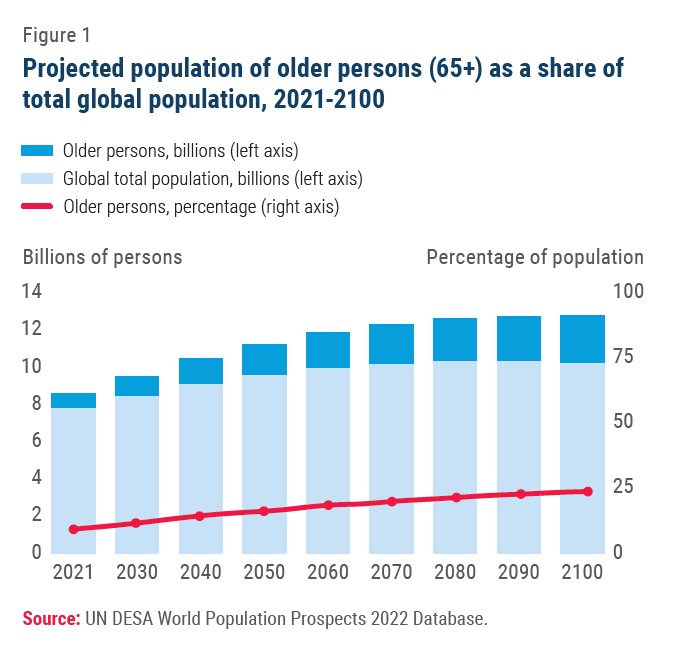 Globally, the number of persons aged 65 years or older is projected to double between 2021 and 2050, from 761 million to 1,603 million people (Figure 1). As early as 2030, the number of older persons will outnumber those under age 20 in Europe. The same will happen by 2050 in Australia and New Zealand, and in Eastern Asia. Between 2020 and 2050 the median age of the global population will increase from 31 years to 36 years with all regions experiencing population ageing. By 2050 three-quarters of all countries, accounting for 87 per cent of the global population, will be “ageing” or already “aged” according to the ILO (Harasty and Ostermeier, 2020).
Globally, the number of persons aged 65 years or older is projected to double between 2021 and 2050, from 761 million to 1,603 million people (Figure 1). As early as 2030, the number of older persons will outnumber those under age 20 in Europe. The same will happen by 2050 in Australia and New Zealand, and in Eastern Asia. Between 2020 and 2050 the median age of the global population will increase from 31 years to 36 years with all regions experiencing population ageing. By 2050 three-quarters of all countries, accounting for 87 per cent of the global population, will be “ageing” or already “aged” according to the ILO (Harasty and Ostermeier, 2020).
As with the overall population, the global workforce is also ageing. The total number of older workers (55-64) is projected to increase from 726 million in 2021 to 1,072 million in 2050 and to 1,250 million by 2100. In Africa, the population of older workers will increase dramatically in the long run, going from 63 million people in 2021 to 161 million in 2050 and 449 million by 2100. The share of older people in the total working-age population will double in Africa from 8.1 per cent in 2021 to 16.3 per cent in 2100 (Figure 2).
 While every country’s population and workforce are ageing, several developing countries are also experiencing an influx of young people into the work force, the result of high fertility rates and a significant reduction in infant mortality. Between 2020 and 2050, 82 countries will experience a net increase in their population aged 15-24 years. In these countries, the young working age population will increase by 151 million, with Africa accounting for 73 per cent of that increase (Figure 3).
While every country’s population and workforce are ageing, several developing countries are also experiencing an influx of young people into the work force, the result of high fertility rates and a significant reduction in infant mortality. Between 2020 and 2050, 82 countries will experience a net increase in their population aged 15-24 years. In these countries, the young working age population will increase by 151 million, with Africa accounting for 73 per cent of that increase (Figure 3).
For some, an influx of young workers offers a demographic dividend
In ageing societies where the ratio of workers to non-workers decreases, the workforce has a bigger role to play to sustain and improve the living standards of the whole population. In countries where a large young population starts to enter the workforce, this effect occasioned by older workers exiting the workforce is offset to some extent. A large increase in new workers increases the ratio of the working to the non-working population, easing the national burden of supporting the non-working population (Figure 4).
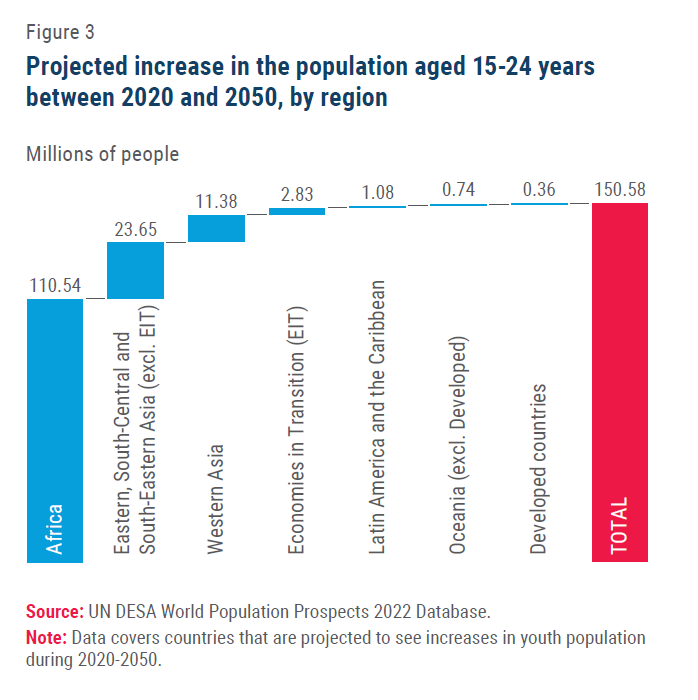 The relative size of working and non-working populations alone does not tell the full story. People of different ages have different consumption needs and different abilities to generate income. Children and the elderly cannot fully finance their consumption needs through current incomes, requiring external support. Young people require investments in health and education while older persons no longer have labour income and consume greater amounts of healthcare services. Working-age adults produce much more than they consume and are therefore a source of financial support, either directly through private transfers, or by tax contributions to public transfer programs.
The relative size of working and non-working populations alone does not tell the full story. People of different ages have different consumption needs and different abilities to generate income. Children and the elderly cannot fully finance their consumption needs through current incomes, requiring external support. Young people require investments in health and education while older persons no longer have labour income and consume greater amounts of healthcare services. Working-age adults produce much more than they consume and are therefore a source of financial support, either directly through private transfers, or by tax contributions to public transfer programs.
The age-specific consumption and production characteristics are measured as the Economic Support Ratio (ESR), defined as the ratio of effective producers and effective consumers. The effective number of producers is the population weighted to incorporate age differences in employment and productivity. The effective number of consumers is the population weighted to incorporate age differences in consumption. The ESR explicitly brings to the fore the economic consequences of ageing, rather than letting it be implied by population sizes alone (Cutler, and others, 1990; Lee, 2016).
By using population projections and historical data on productivity and consumption by age group it is possible to estimate the path of the ESR for countries (Figure 5). Societies that are ageing without a sufficient influx of young people into the workforce will experience a decline in their ESRs over the coming decades. This decline has already begun in high-income countries and upper middle-income countries. In lower middle-income countries and low-income countries, the projections are more benign due to the expected large influx of young workers. In these countries, standards of living for the population at large could improve, should the benefits of a relatively large, young workforce be fully realized.
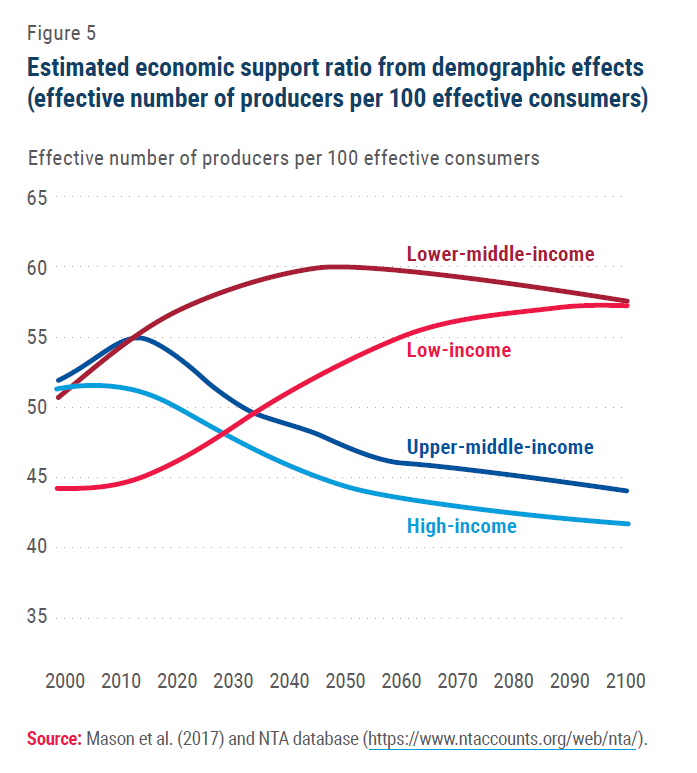 In the context of this brief, a high ESR represents the potential for realizing a “demographic dividend” for countries as they have additional capacity to support their population and invest in their societies. Fifty-six countries are experiencing this dividend, including 38 in Africa; 10 in Asia; 5 in Latin America and the Caribbean, and 3 in Oceania (Figure 6). These 56 countries account for 69, 13, 6, and 23 per cent of the population in these regions respectively.
In the context of this brief, a high ESR represents the potential for realizing a “demographic dividend” for countries as they have additional capacity to support their population and invest in their societies. Fifty-six countries are experiencing this dividend, including 38 in Africa; 10 in Asia; 5 in Latin America and the Caribbean, and 3 in Oceania (Figure 6). These 56 countries account for 69, 13, 6, and 23 per cent of the population in these regions respectively.
How the demographic dividend helps with economic growth
There is a limited window of time—one which may already be closing—within which countries must act to realize their demographic dividend. While countries at the early stages of the demographic transition may take various steps to improve the proportion of their population that is at work, increased labour productivity is essential for narrowing the income gap with higher-income countries.
This conclusion is supported by a simulation exercise for the 2020-2050 period that assessed the impact of three policy actions that complement higher labour productivity to achieve desired rates of growth: i) achieving gender parity in the labour force participation rate; ii) raising the retirement age (from 65 to 70); and iii) improving the youth employment rate (to match that of the rest of the labour force). The simulation shows that each of these initiatives can lower the annual labour productivity growth required for achieving the income growth target by 5.7 per cent, 2 per cent, and 1.0 per cent, respectively. And in the case of the 10 countries that can benefit the most, the exercise shows that these three factors together can bring down the required labour productivity growth by 21.7 per cent on average.
The experience of wealthier countries with their past demographic transition, confirms that maintaining an annual rate of productivity growth sufficient to support a growing and ageing population requires large improvements in productivity (Figure 7). A corollary is that in upper middle-income countries the declining labour force as a share of the population has had a negative influence on GDP growth since 2013. This trend will accelerate in the coming decades, as will the decline in the ESR. For these countries, either productivity or participation in the workforce must increase by a similar rate just to maintain the current standard of living.
In high-income countries, even as the influence of productivity and of working age population size on GDP per capita growth declined, rates of employment and of labour force participation have supported per capita growth. The experience of wealthier countries in dealing with their declining ESR and maintaining their standard of living provides a roadmap for what will be needed by countries as their populations and work forces age.
In low-income countries the contribution from working age population growth to total economic growth has increased, but this hasn’t been enough to offset the fall in productivity these countries have experienced since 2010. Low-income countries have also seen a negative effect from changes to their rates of labour force participation since 2005. These countries would need to reverse recent trends and engineer a significant positive contribution from productivity and labour force participation rates if they wish to stop and reverse the decline in per capita growth experienced during the last 15 years.
For lower middle-income countries, growth in the working age population has occurred as productivity growth remained strong. As with low-income countries, declines in the labour force participation rate have generally offset these gains, highlighting the importance of labour market policies and outcomes that can prevent such erosion.
Clearly, context matters. The macroeconomic link between ageing and growth is complex. The evidence indicates that the overall effect of an ageing national population on total labour productivity is quite small compared to the influence of other factors such as education and institutional support (National Research Council, 2012). Older persons have accumulated knowledge and experience that increases their productivity. However, the overall effect of ageing on economic growth and productivity depends in large part on the response of firms. Ageing may lead to lower demand for certain types of businesses, however the effect on investment in machinery and equipment is less clear. New technologies such as digitalization and automation can be used to increase output per worker and per capita, but this depends on the availability of financing for firms to make the necessary investments. Additionally, some evidence points to rising relative hourly wages among older workers and increasing GDP per capita with ageing populations (IMF, 2019).
Capitalizing on technology to realize demographic dividends
In light of recent productivity and demographic trends, it is crucial that developing countries actively pursue the benefits from the demographic bonus brought by a younger population in order to adequately prepare for an imminent future with greater population ageing. In practice, they can do so by better preparing young people for the jobs of today and of the future, a task where the role of technology is pre-eminent.
In 2019, prior to the COVID-19 pandemic, the global unemployment rate stood at 5.4 per cent. Compared to average rates, unemployment among younger workers is much higher in every region of the world and has hardly changed since 2005. In poorer countries, young people of working age (between 15 and 24 years) are more than twice as likely not to be working, in school or in training, compared to young people in high income countries (Figure 8). The COVID-19 pandemic made the problem worse during 2020 and 2021 as all regions experienced a spike in the share of global youth not in employment, education, or training (NEET) (ILO, 2022). The latest data shows that the global youth NEET share rose in 2022 to 23.5 per cent, down from the 24.9 per cent peak observed in 2020, but broadly continuing the upward trend witnessed during the 2012-2019 period. The long-term consequences will likely be severe as high numbers of people not being educated or trained affect the future potential for growth and productivity.
Lowering the share of young people outside education or the labour force is one way that countries can counteract some of the headwinds from an ageing population. Young workers, who are typically less productive due to their limited experience and skills, often face challenges when entering the workforce. Additionally, they may be less likely to participate in the labour market, even after completing their education (ILO, 2022). In a scenario where the youth unemployment rate (ages 15-24) in all countries is lowered to match that of the rest of the working age population, GDP would be 1.6 per cent higher on average. For African countries GDP would be 2.7 per cent higher on average (Figure 9).
Substantial benefits also arise from bringing more women into the labour force. Globally, there is a gap of 20 percentage points between male and female rates of labour force participation, ranging between 31.2 percentage points in Asia and 8.7 per cent in North America. A simulation shows that, assuming no dynamic effects or other changes, eliminating the gender gap in the labour force participation rate would add another 30 per cent to global GDP per capita. The halving of this gap from the current level would be expected to increase the global GDP per capita by 22 per cent. This amount can be considered the global opportunity cost of lower labour force participation of women.
Policy options and priorities are clear. Identify the essential skills needed for the future, make ICT and digital technologies accessible to individuals and firms, and invest in education and curricula that prepare workers with the skills needed in higher value-added industries.
Identifying the essential skills needed for higher productivity jobs
Countries must identify the skills and education necessary to make young workers more employable for the jobs of today and to develop an education system that can prepare future workers for the jobs of tomorrow.
A recent study on the impact of digital transformation on unemployment in Egypt’s mobile operators shows that the upskilling of youth on the use of new technologies and the reskilling of current workers to perform associated tasks (problem-solving, permanent learning, setting up plans, team management) is particularly effective if they are targeted at the newly created jobs (Elsafty and Elzeftawy, 2022).
Digital technologies can help countries create national and industry skills maps, providing them a clear sense of what types of skills are or will be in demand, given existing technology trends. Big data analytics can be used to analyze the massive trove of job vacancies data that are published online on job search platforms and professional social networks generating real-time insights on skills demand captured in job descriptions, much faster than survey-based analyses. Machine learning algorithms that analyze job announcements can help detect emerging occupations and required skills, which allow governments and corporations to promptly provide appropriate training for new workers. The mapping of skills supported by machine learning has demonstrated potential, including for developing countries as illustrated by experiments done in Latin America and the Caribbean region, India and Myanmar (ILO, 2020).
Building the infrastructure needed to support human capital
To reduce the skills acquisition gap, ICTs can help educational institutions provide youth with a range of options to continue learning and to adapt to changing skills requirements. ICTs are particularly effective in responding to the rapid changes at work and in society brought about by new technologies, requiring flexible and lifelong learning systems. Some of the more compelling ICTs for skills acquisition are virtual reality (VR) and augmented reality (AR) technologies. It has been shown that users retain information better when it is presented in VR instead of on a computer screen (Krokos, Plaisant and Varshney, 2019). In South Africa, forestry students use VR technology to learn how to operate chainsaws, keeping them interested and safe at the same time (De Oliveira Pereira, 2018). In Myanmar, AR educational applications have been developed to deliver lessons on smartphones that are easily accessible to the population (Damm, 2019). Also, training of soft skills using VR can be four times faster than in traditional in-person classrooms or online training settings (PricewaterhouseCoopers, 2022).
The technology infrastructure needed to support human capital development includes digital technology platforms and services. Gig-economy technology platforms, for example, create opportunities for young workers in every sector. The jobs available from these digital platforms are particularly attractive to younger workers who, according to a recent ILO survey, learn faster and thus earn higher hourly wages compared to their older counterparts on these platforms (Caro, O’Higgins and Berg, 2021). These platforms help those without a job history, including many young people, to build their reputation and secure higher wages through positive reviews. Sharing and gig-economy platforms can also help reduce informality by formalizing payments, encouraging workers to open bank accounts, expanding employment-linked social protection schemes, and facilitating tax collection (Cheng, and others, 2020). Yet, while gig-economy jobs provide workers with flexibility and employment opportunities, many non-standard work arrangements lead to precarious work relations, with workers having to bear employment and income risks by themselves (UN DESA, 2017).
One of the main challenges for young people in low- and middle-income countries to benefit from platform-based work is their ability to access it (ILO, 2022). One-third of the world’s population, or 2.7 billion people, do not have access to the Internet. Young people are more likely to access the Internet, but a quarter of them remain without access as of 2022. There is also a gender gap in Internet access of nearly 10 percentage points. Governments must redouble their efforts to end the digital divide that prevents young people from gaining skills and experience that are so important to young developing economies. The specific challenges for developing countries will require public policies designed to reduce inequalities across multiple dimensions. In Mexico for example, only 40 per cent of socio-economically disadvantaged students have access to computers in schools, against 70 per cent of socio-economically advantaged students (Schleicher, 2019).
On a macroeconomic scale, digital platforms help many businesses that are already important in developing countries, such as agro-processing, transport, distribution, marketing, retail, tourism, manufacturing, construction and mining, and self-employment. According to Pinduoduo, one of the largest e-commerce platforms in terms of sales in China, more than 10,000 industries have been involved in the supply chain it created. In India, Reliance Retail, the biggest brick-and-mortar retailer, is expanding access into even the most remote regions by utilizing its smaller locations in more than 5,000 cities and towns as the last mile connection point for its e-commerce venture, to reach consumers without Internet access or who have never shopped online. The expansion of businesses has a demonstrated contribution to economic growth, household income diversification, employment, poverty reduction, and a more spatially balanced population distribution in most developing countries (World Bank, 2016).
Improving education and the human capital of the future
Investments in education are needed to develop the skills young people will need to enter the workforce. Greater access to quality secondary and tertiary education and vocational training would ensure that young people have the skills needed to access more productive work. Policymakers can help by adapting education curricula, promoting STEM education, and including computer science, entrepreneurship and interpersonal skills education. However, it is also important to develop skills for work and life, which include not only technical and vocational skills but also soft skills such as communication, teamwork and problem-solving. These skills are essential for individuals to find decent work and contribute to building a peaceful, healthy, just and sustainable world. In many developing countries strengthening the educational system will require the hiring and retention of quality educators, proper funding for educational institutions, and high standards for student achievement.
Strengthening education in science, technology, engineering and mathematics can help harness the potential impact of technology on innovation and economic growth. It equips workers with skills that make them less likely to be replaced by automation. Technology also boosts employment opportunities and wages for young women, in particular, by at first providing greater access to education and also by de-emphasizing physical skills in favor of computer and cognitive attributes (UN DESA, 2017). However, to fully realize these gains, it is crucial to also invest in improving soft skills such as communication, teamwork, and problem-solving.
Broader usage of ICT will be crucial to expand the provision and quality of education. Despite progress in expanding access to education and increasing school enrollment over the past decade, particularly in terms of gender parity, nearly one-fifth of the global population of school age children was out of school in 2018. The situation deteriorated further due to the COVID-19 pandemic, as school closures affected more than 94 per cent of students worldwide (UN, 2020). This generation of students is at risk of losing $17 trillion in lifetime earnings at present value, the equivalent of 14 per cent of today’s gross world product (The World Bank, UNESCO, and UNICEF, 2021; LaFleur, and others, 2022).
For young people that have recently entered the labour force, training must remain relevant to the ever-changing labour market demand. Everywhere young people face difficulties in identifying or acquiring skills needed for today’s job markets. Innovation in education and training—based on online learning platforms and other technologies—has helped to address some of the skilling-related challenges young workers face. Online learning, including Massive Open Online Courses (MOOC), has the potential to build new learning pathways towards tertiary education and lifelong learning. These types of open education resources are valuable for workers who need to update their skills and for individuals who left the education system too early without adequate education for the new demands in labour markets (Schleicher, 2019).
Policies aimed at reducing informality—entrenched in many parts of the world—are also important. In many developing countries there are large economy-wide efficiency gains possible by increasing productivity in the traditionally low-skilled informal economy, where a large share of workers is employed. Reducing youth unemployment and reaching the informal sector is difficult and remains an important policy challenge in developing countries. Increased investment in infrastructure and human capital is particularly important for improving productivity in such country contexts. Improved access to technology and the creation of forward and backward linkages in the supply chain between the formal and informal sectors can also enhance the skills of workers and ultimately lead to higher overall productivity growth (UN DESA, 2021).
Conclusion
The populations of nearly all countries are experiencing growth in size and proportion of older individuals, leading to changes in consumption and production patterns that present challenges for the economy. Many lower-income countries, especially in sub-Saharan Africa, will also see a significant increase in their young working-age populations. This presents a unique opportunity to be better prepared for the inevitability of population ageing in the immediate foreseeable future. A demographic dividend, if realized, would boost economic growth through heightened productivity, greater savings and investment, and a surge in consumer demand. These factors can create a positive feedback loop that further stimulates domestic production, job creation and innovation.
However, the economic benefits from the demographic dividend are not guaranteed, and countries must invest and plan strategically to fully harness its potential. This starts with rapidly improving how young and existing workers are prepared for current and future jobs, including investing in education and skills development to ensure a well-equipped workforce, promoting investment by firms and ensuring gender equality in labour markets. Additionally, governments must focus on reducing informality in the labour market, guaranteeing universal access to quality education and skills development, as well as providing better infrastructure for technology access.
To achieve these goals, specific policy interventions are necessary, such as closing the digital divide, ensuring accessibility of ICT and digital technologies for all, investing in education tailored for the future economy and fostering innovations that create opportunities with new technologies. Strengthening education in science, technology, engineering, and mathematics can help build a solid foundation for the larger role of the technology sector in the economy and provide workers with the necessary skills to adapt to the changing labour market. Moreover, it is crucial to develop comprehensive policies that support the transition from school to work, enhance lifelong learning opportunities, and address the needs of disadvantaged groups. By implementing these strategies, countries can effectively utilize the demographic dividend and drive sustainable economic growth while also preparing for a future with an increasingly aged population.

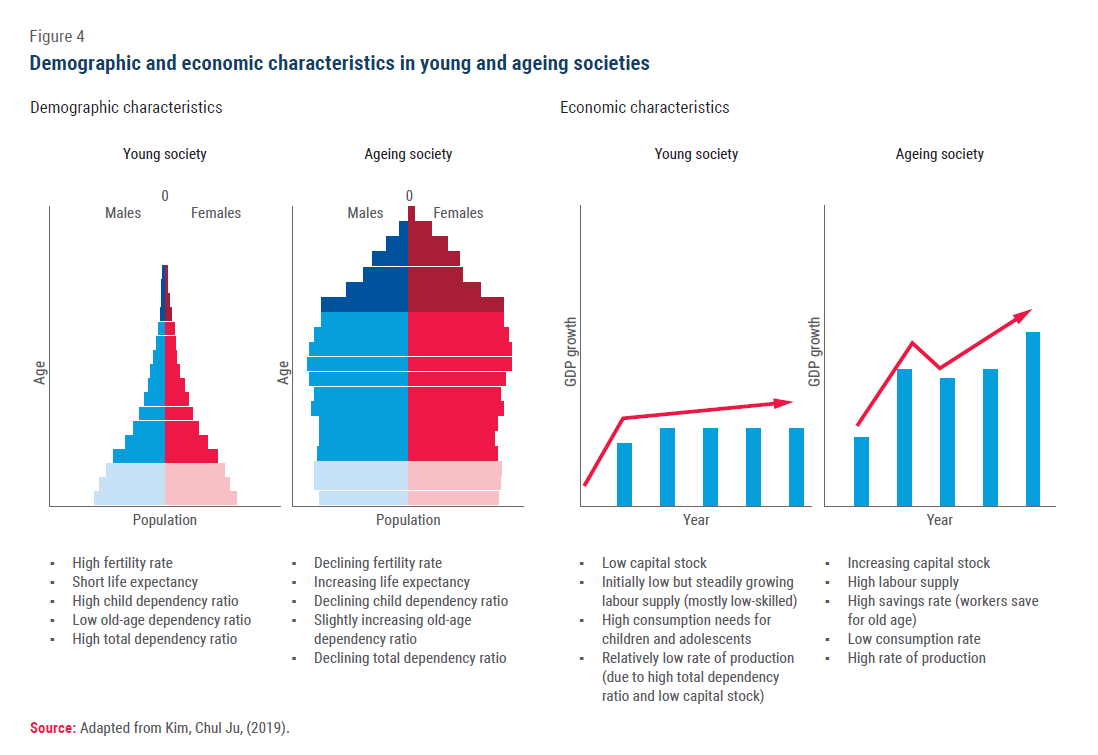

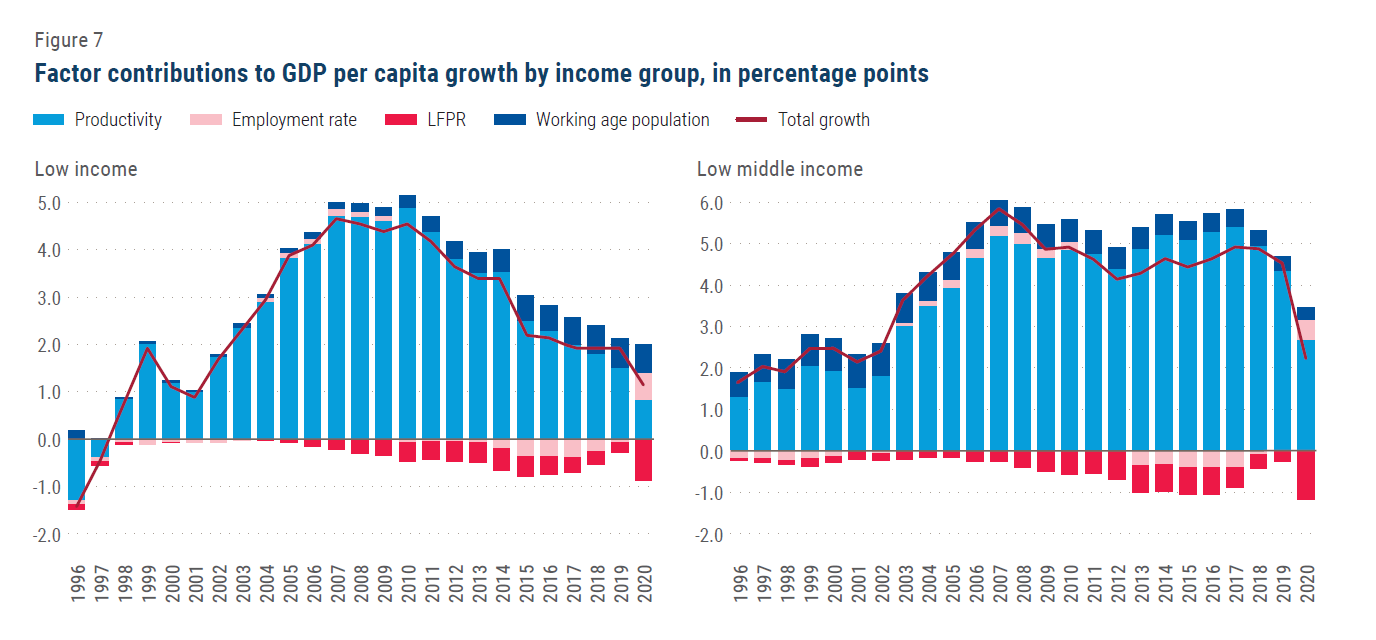

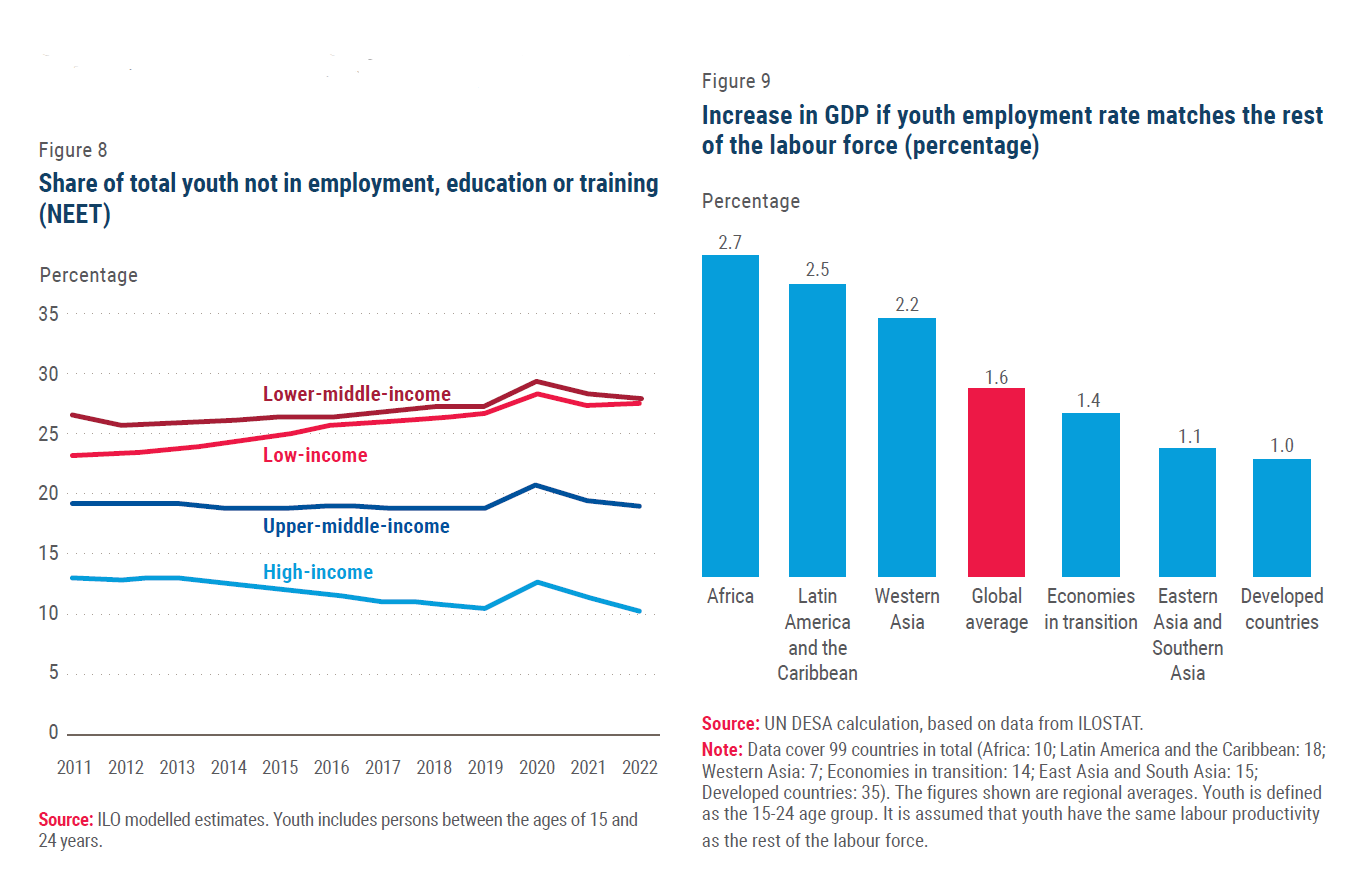
Follow Us